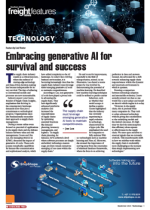Within the supply chain, as well as revealing vulnerabilities machinelearning is gaining momentum within the freight sector, as computers demonstrate the remarkable ability to identify and automatically populate forms based on prior documentation or historical learning, according to Michael Henning, sales manager at Easy Clear.Another significant development is the Internet of Things (IoT), which is enabling the collection of an unprecedented amount of data. IoT devices and sensors are deployed across various points in the supply chain, from ports of entry to distribution centres, providing real-time information on everything from inventory levels to environmental conditions. "The analysis of data sourced from diverse channels is actively pinpointing potential optimisation opportunities within the supply chain, as well as revealing vulnerabilities that demand prompt intervention. This holds especially true when examining the various ports of entry and the constraints that have become increasingly apparent within some of South A fr ica's busiest logistics corridors," said Henning.Interest in Artificial Intelligence (AI), Augmented Reality (AR), and Virtual Reality (VR) continue to surge, although these technologies are not uniformly integrated into the supply chain. “Certainly, some of these technologies are capturing more attention than others,” said Henning. “The implementation of blockchain technology in the FMCG and sea freight sectors is particularly noteworthy. This technology offers a robust solution for managing critical documents like the bill of lading, and facilitating contract negotiations. Additionally, it enables the tracing of goods back to their origins, ensuring transparency and compliance with legislation. For instance, it allows for the traceability of products like palm oil all the way back to the farm where it was sourced, underscoring the significance of this adoption.“Locally, Henning said, while not entirely new, Easy Clear's software-as-a-service (SaaS) application had enabled digitalisation processes by converting physical information into digital formats. “This transformative approach allows businesses to store documents digitally, making them easily retrievable and printable on demand. Technology allows us to meet the demands of a rapidly changing economic climate and provide data on demand and ease of use, utilising smart devices and mobile data to bring information to our clients’ fingertips.”He said the company was constantly focused on bringing innovative solutions to its products and clients

